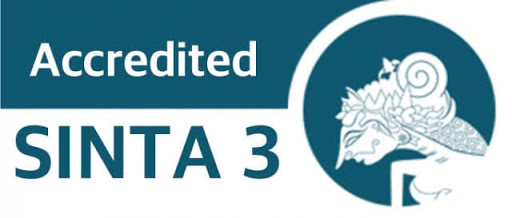UTILIZING JIGSAW METHOD TO IMPROVE LEARNING ACTIVITIES AND STUDENTS’ HISTORY LEARNING OUTCOME AT CLASS XII IPS (SOCIAL SCIENCE) OF SMA NEGERI 10 PEKANBARU
Abstract
The purpose of this study was to improve the activities and learning outcomes in two cycles. An initial test was conducted before carrying out the learning process. The score in the pre-cycle was 2390; the score in cycle I was 2885, and the score in cycle II was 3070. Meanwhile, the average score in th pre-cycle was 68.29, in cycle I, it increased to 78.92 and cycle II, it increased to 87.71. The score was obtained based on minimum learning mastery (KKM) which was 80. In the pre-cycle, there were only 8 students (22.86%) who reached the KKM while 27 students did not reach the KKM (77.14%). In cycle 1, 24 students (68.57%) reached the KKM and 11 students did not reach the KKM (31.43%). Moreover, in cycle II, 34 students reached the KKM (97.14%) and only 02.86% of students did not reach the KKM. From these results, the highest score in pre-cycle was 85 and the lowest score was 45; the highest score in cycle I was 95 and the lowest score was 75. In addition, based on the range and criteria of the score, the percentage in pre-cycle was 3143% (enough), in cycle I was 37.14% (very high), and in cycle II was 51.43% (very high). Then, students’ activity in each cycle increased for 71.43 and 85.71 respectively. It could be concluded that jigsaw method improved the learning activity and students’ learning outcomes at class XII IPS SMA Negeri 10 Pekanbaru.
Keywords
Full Text:
PDF (BAHASA INDONESIA)References
Arends. (2001). Kelemahan dan Kelebihan cooperative learning tipe jigsaw (Online)(http://.blogspot.pengertian dan langkah-langkah kelebihan diakses tanggal 15 Juni 2018.
Budi, W. (2015). Pengertian Pembelajaran Inovatif dan Type-Typenya. https://pustaka guru/ Pemblajaran inovatif diakses tanggal 15 Juni 2018
Dimyati dan Mulyono. (2006). Belajar dan Pembelajaran. Jakarta: PT Rineke Cipta.
Jihad A dan Haris A (2012) Evaluasi Pembelajaran. Yogyakarta: Multi Presindo.
Lexy J. Moleong (2013) Metode Penelitian Kualitatif. Edisi Revisi. Bandung: PT. Remaja Rosdakarya.
Mel Silberman. (2007). Active Learning,, Yogyakarta: Pustaka Insan Madani.
Mills.G.E. (2003). Action Reseachch: A Guid for the Teacher Reseachcher Columbus. Merrill. An Imprint of Prentice Hall.
Mulyasa, E. (2006). Menjadi Guru Profesional Menciptakan Pembelajaran Kreatif dan Menyenangkan. Bandung: Remaja Rosdakarya.
Mushlihin. (2012) Kegiatan Siswa dan Kegiatan Guru Dalam Pembelajaran. Online https://pustaka guru diakses 15 Juni 2018
Nasution, S. (2000). Berbagai Pendekatan dalam Proses Belajar Mengajar. Jakarta: PT Bumi Aksara.
Netti, E. (2016). Penggunaan Metode Jigsaw untuk Meningkatkan Aktivitas dan Hasil Belajar Sosiologi Materi Konplik Sosial Kelas XI SMA Negeri 4 Pekanbaru Tahun Pelajaran 2013-2014 Jurnal Sorot 10. LPPM.Universitas Riau. ISSN 1907364X hal 19-35.
Rusman. (2008). Pembelajaran Tematik Terpadu, Teori Praktik dan Penilaian. Jakarta: Grafindo.
Sanjaya, W. (2010). Startegi Pembelajaran Berorientasi Standar Proses Pendidikan. Jakarta: Kencana.
Setianto. Yudi (2011) Hakikat Pembelajaran Sejarah dan Permasalahan. Batu: Laborium IPS P4tk PKn dan IPS Batu.
Sugiono. (2006) Metode Penelitian Kuantitatif, Kualitatif, R & D. Bandung: PT Alfabet.
Suhardjono. (2007). Penelitian Tindakan Kelas. Jakarta: Bumi Aksara.
Suprijono, A. (2013). Cooperatif Learning. Surabaya: Pustaka Belajar.
Trianto. (2011). Model Pembelajaran Terpadu, Konsep, Strategi, dan Implimentasi dalam Kurikulum Tingkat Satuan Pelajaran (KTSP). Jakarta: Bumi Aksara.
DOI: http://dx.doi.org/10.33578/pjr.v5i1.8226
Refbacks
- There are currently no refbacks.
Copyright (c) 2021 JURNAL PAJAR (Pendidikan dan Pengajaran)

This work is licensed under a Creative Commons Attribution-NonCommercial-ShareAlike 4.0 International License.
JURNAL PAJAR (Pendidikan dan Pengajaran)
Secretariat
Program Studi Pendidikan Guru Sekolah Dasar
Gedung B1, FKIP Universitas Riau
Kampus Bina Widya Km. 12,5 Simpang Baru Panam
Pekanbaru Riau Indonesia 28293
e-mail : pajar@ejournal.unri.ac.id



